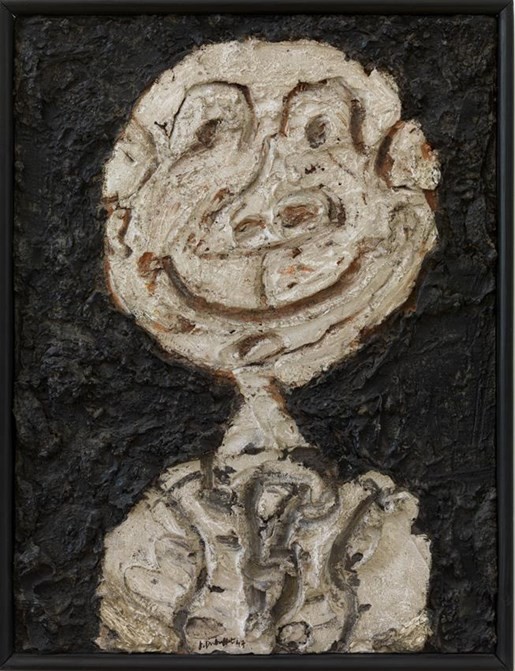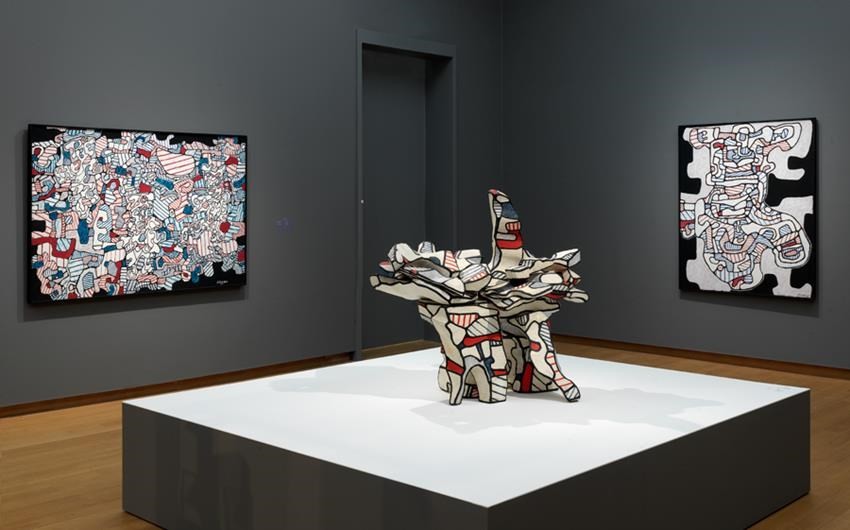Jean Dubuffet
The Deep End
01 Jul 2017 - 07 Jan 2018

Jean Dubuffet
Personnage hilare (Portrait de Francis Ponge), 1947
oil paint on plaster on cardboard
60.5 x 45.5 cm
collection Stedelijk Museum Amsterdam.
Personnage hilare (Portrait de Francis Ponge), 1947
oil paint on plaster on cardboard
60.5 x 45.5 cm
collection Stedelijk Museum Amsterdam.
JEAN DUBUFFE
The Deep End
1 July 2017 - 7 January 2018
Curated by Dr. Sophie Berrebi
This summer, the Rijksmuseum and the Stedelijk Museum Amsterdam are programming work by the French artist Jean Dubuffet (1901-1985). The Rijksmuseum will present sculptures by the artist in the museum gardens and, for the first time, the Stedelijk will exhibit the entire group of Dubuffet works in its collection.
How can you capture thoughts that shoot off in all directions, in a painting? And how can you represent a world that is beyond objective reality in a work of art? From the 1940s onwards, these were the questions that constantly preoccupied Jean Dubuffet.
The first gallery of the exhibition presents paintings and lithographs made in the 1950s, when the artist experimented with materials not usually used in painting, such as asphalt. Dubuffet’s compositions were also deliberately confusing: he worked with two overlapping perspectives – the scene seen from a frontal elevation, and the panoramic perspective.
In the second gallery, the emphasis is on paintings and sculptures made during the 1960s, when Dubuffet was working on an ‘irrational world’, in a series of works in which he reduced figures, landscapes and objects to a tangle of black lines against a white background with accents of colour. The result is a mystifying illusion of hollows and bulges.
Edy de Wilde, director of the Stedelijk from 1963 to 1985, amassed a large collection of pieces by Dubuffet and, in the 1960s, staged exhibitions of his work. De Wilde’s acquisition policy favoured buying the work of contemporary artists, leading him to purchase a number of pieces directly from Dubuffet. Eager to ensure that a representative selection of his work would be seen in a European museum, the artist also gifted a number of pieces to the Stedelijk in 1965.
MORE ABOUT THE ARTIST
In the 1950s and ‘60s, Jean Dubuffet was principally known as a painter, draughtsman and print-maker. Towards the end of the 1940s and throughout the ‘50s, he was instrumental in encouraging the widespread use of the term ‘art brut’, or raw art, for artwork created by the mentally ill, children, and autodidacts. The unadulterated and untainted creativity and power of such images were hugely inspirational for 20th century artists desperately in search of innovation – artists such as the Dutch members of the CoBrA group (Constant, Corneille, Karel Appel). As the 1960s progressed, Dubuffet’s work grew more graphic in nature, and the single human and animal figure was replaced by intricate scenes composed of contour lines around ‘cells’ in bright colours.
How can you capture thoughts that shoot off in all directions, in a painting? And how can you represent a world that is beyond objective reality in a work of art? From the 1940s onwards, these were the questions that constantly preoccupied Jean Dubuffet. The first gallery of the exhibition presents paintings and lithographs made in the 1950s, when the artist experimented with materials not usually used in painting, such as asphalt. Dubuffet’s compositions were also deliberately confusing: he worked with two overlapping perspectives – the scene seen from a frontal elevation, and the panoramic perspective. In the second gallery, the emphasis is on paintings and sculptures made during the 1960s, when Dubuffet was working on an ‘irrational world’, in a series of works in which he reduced figures, landscapes and objects to a tangle of black lines against a white background with accents of colour. The result is a mystifying illusion of hollows and bulges. Edy de Wilde, director of the Stedelijk from 1963 to 1985, amassed a large collection of pieces by Dubuffet and, in the 1960s, staged exhibitions of his work. De Wilde’s acquisition policy favoured buying the work of contemporary artists, leading him to purchase a number of pieces directly from Dubuffet. Eager to ensure that a representative selection of his work would be seen in a European museum, the artist also gifted a number of pieces to the Stedelijk in 1965. MORE ABOUT THE ARTIST In the 1950s and ‘60s, Jean Dubuffet was principally known as a painter, draughtsman and print-maker. Towards the end of the 1940s and throughout the ‘50s, he was instrumental in encouraging the widespread use of the term ‘art brut’, or raw art, for artwork created by the mentally ill, children, and autodidacts. The unadulterated and untainted creativity and power of such images were hugely inspirational for 20th century artists desperately in search of innovation – artists such as the Dutch members of the CoBrA group (Constant, Corneille, Karel Appel). As the 1960s progressed, Dubuffet’s work grew more graphic in nature, and the single human and animal figure was replaced by intricate scenes composed of contour lines around ‘cells’ in bright colours.
The exhibition Jean Dubuffet: The Deep End is curated by guest curator Dr. Sophie Berrebi, lecturer in art history at the University of Amsterdam.
In her essay for the catalogue of the Rijksmuseum, Berrebi writes of Dubuffet’s history with the Netherlands and the Stedelijk, a history that began when his work was discovered by Corneille and Karel Appel in Paris in 1947, and the first works acquired for the collection by director Willem Sandberg in the 1950s.
The exhibition Jean Dubuffet: The Deep End is curated by guest curator Dr. Sophie Berrebi, lecturer in art history at the University of Amsterdam. In her essay for the catalogue of the Rijksmuseum, Berrebi writes of Dubuffet’s history with the Netherlands and the Stedelijk, a history that began when his work was discovered by Corneille and Karel Appel in Paris in 1947, and the first works acquired for the collection by director Willem Sandberg in the 1950s.
The Deep End
1 July 2017 - 7 January 2018
Curated by Dr. Sophie Berrebi
This summer, the Rijksmuseum and the Stedelijk Museum Amsterdam are programming work by the French artist Jean Dubuffet (1901-1985). The Rijksmuseum will present sculptures by the artist in the museum gardens and, for the first time, the Stedelijk will exhibit the entire group of Dubuffet works in its collection.
How can you capture thoughts that shoot off in all directions, in a painting? And how can you represent a world that is beyond objective reality in a work of art? From the 1940s onwards, these were the questions that constantly preoccupied Jean Dubuffet.
The first gallery of the exhibition presents paintings and lithographs made in the 1950s, when the artist experimented with materials not usually used in painting, such as asphalt. Dubuffet’s compositions were also deliberately confusing: he worked with two overlapping perspectives – the scene seen from a frontal elevation, and the panoramic perspective.
In the second gallery, the emphasis is on paintings and sculptures made during the 1960s, when Dubuffet was working on an ‘irrational world’, in a series of works in which he reduced figures, landscapes and objects to a tangle of black lines against a white background with accents of colour. The result is a mystifying illusion of hollows and bulges.
Edy de Wilde, director of the Stedelijk from 1963 to 1985, amassed a large collection of pieces by Dubuffet and, in the 1960s, staged exhibitions of his work. De Wilde’s acquisition policy favoured buying the work of contemporary artists, leading him to purchase a number of pieces directly from Dubuffet. Eager to ensure that a representative selection of his work would be seen in a European museum, the artist also gifted a number of pieces to the Stedelijk in 1965.
MORE ABOUT THE ARTIST
In the 1950s and ‘60s, Jean Dubuffet was principally known as a painter, draughtsman and print-maker. Towards the end of the 1940s and throughout the ‘50s, he was instrumental in encouraging the widespread use of the term ‘art brut’, or raw art, for artwork created by the mentally ill, children, and autodidacts. The unadulterated and untainted creativity and power of such images were hugely inspirational for 20th century artists desperately in search of innovation – artists such as the Dutch members of the CoBrA group (Constant, Corneille, Karel Appel). As the 1960s progressed, Dubuffet’s work grew more graphic in nature, and the single human and animal figure was replaced by intricate scenes composed of contour lines around ‘cells’ in bright colours.
How can you capture thoughts that shoot off in all directions, in a painting? And how can you represent a world that is beyond objective reality in a work of art? From the 1940s onwards, these were the questions that constantly preoccupied Jean Dubuffet. The first gallery of the exhibition presents paintings and lithographs made in the 1950s, when the artist experimented with materials not usually used in painting, such as asphalt. Dubuffet’s compositions were also deliberately confusing: he worked with two overlapping perspectives – the scene seen from a frontal elevation, and the panoramic perspective. In the second gallery, the emphasis is on paintings and sculptures made during the 1960s, when Dubuffet was working on an ‘irrational world’, in a series of works in which he reduced figures, landscapes and objects to a tangle of black lines against a white background with accents of colour. The result is a mystifying illusion of hollows and bulges. Edy de Wilde, director of the Stedelijk from 1963 to 1985, amassed a large collection of pieces by Dubuffet and, in the 1960s, staged exhibitions of his work. De Wilde’s acquisition policy favoured buying the work of contemporary artists, leading him to purchase a number of pieces directly from Dubuffet. Eager to ensure that a representative selection of his work would be seen in a European museum, the artist also gifted a number of pieces to the Stedelijk in 1965. MORE ABOUT THE ARTIST In the 1950s and ‘60s, Jean Dubuffet was principally known as a painter, draughtsman and print-maker. Towards the end of the 1940s and throughout the ‘50s, he was instrumental in encouraging the widespread use of the term ‘art brut’, or raw art, for artwork created by the mentally ill, children, and autodidacts. The unadulterated and untainted creativity and power of such images were hugely inspirational for 20th century artists desperately in search of innovation – artists such as the Dutch members of the CoBrA group (Constant, Corneille, Karel Appel). As the 1960s progressed, Dubuffet’s work grew more graphic in nature, and the single human and animal figure was replaced by intricate scenes composed of contour lines around ‘cells’ in bright colours.
The exhibition Jean Dubuffet: The Deep End is curated by guest curator Dr. Sophie Berrebi, lecturer in art history at the University of Amsterdam.
In her essay for the catalogue of the Rijksmuseum, Berrebi writes of Dubuffet’s history with the Netherlands and the Stedelijk, a history that began when his work was discovered by Corneille and Karel Appel in Paris in 1947, and the first works acquired for the collection by director Willem Sandberg in the 1950s.
The exhibition Jean Dubuffet: The Deep End is curated by guest curator Dr. Sophie Berrebi, lecturer in art history at the University of Amsterdam. In her essay for the catalogue of the Rijksmuseum, Berrebi writes of Dubuffet’s history with the Netherlands and the Stedelijk, a history that began when his work was discovered by Corneille and Karel Appel in Paris in 1947, and the first works acquired for the collection by director Willem Sandberg in the 1950s.


